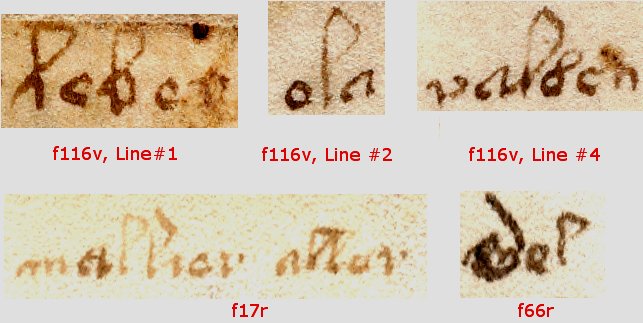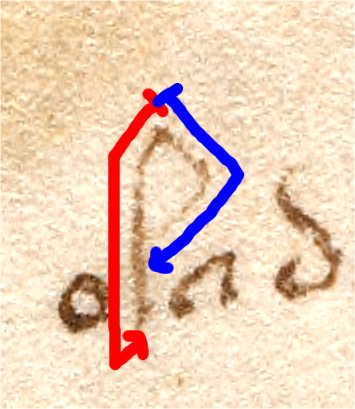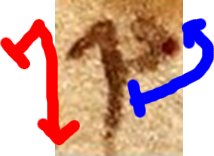Following on from yesterday’s post on Elmar’s marginalia PDF, I’ve once again been looking really closely at the Voynich marginalia. I’m using the modern kind of fuzzily-overlapping codicology / palaeography / linguistic methodology that sometimes gets mentioned online (but which may be more to do with university administrators’ desire to collapse three history lecturing posts into one) to try to model the underlying hand, one careful stroke at a time.
Yesterday, I decomposed the ‘a’ into what I think its constituent strokes are: a curved ‘c’-stroke (red, above) followed by a zigzaggy ‘z’-stroke (blue, above). Now here’s a collection of ‘l’ shapes (and note once again that these are consistent across the various marginalia, just as the “pre-upstroked topless p” marginalia character proved to be back here)…
…and the two constituent continuous strokes that I think make up the ‘l’ shape…
My reasoning is; that you can see where the ink pools slightly at the overlap (right at the top); that it’s always easier to do downstrokes than upstrokes with a quill; that the NE-to-SW end part of the second (blue) stroke sometimes crosses over the vertical stroke (most notably in the “por le bon” instance); and that the vertical downstroke seems evenly inked from top to bottom, consistent with a single long stroke.
Similarly, here’s how I think the ‘topless p’ character was stroked, with the second (blue) stroke pushed upwards, which I guess accounts for why it stops short:-
Now, the real question is: how can we use this basic codicological and palaeographic knowledge to help us? Tentatively, I suspect we can now identify the hand as a kind of “French Secretary” hand (as shown on this page on Dianne Tillotson’s excellent site) with perhaps just a hint of Italian mercantesca (as illustrated in this paper by Irene Ceccherini). The two-stroke ‘a’ with a peak-y arch seems quite distinctive: probably the next good step would be looking for old-fashioned palaeography books in Gallica, see what kind of a literature there is on the subject.
Anyway, good luck looking for French Secretary hands with topless p-shapes (but be careful of the keywords you use on Google, you may get something of a high ranking surprise)… 😮




For what it’s worth, the second character in your fragment of f17r
seems to me to be similar to one in the second word before ‘portas’
on the top of f116v, and to the second character in ‘geiss’.
(I am not transcribing words here, but use the form under which they
are best known). I’ve seen sample texts where this represents an ‘a’.
See e.g. the following link to Cod. Pal. germ. 63, a MS from the 2nd
quarter of the 15th C (I ‘ve seen better examples than this one).
http://diglit.ub.uni-heidelberg.de/diglit/cpg63/0016/image?sid=e85f36d0562fb9b412ec00c1d4136485#current_page
It also has at least one topless p…
Rene: the second ‘a’-like character would seem to be an emendation, so I’d suggest being careful about what inferences you draw from it. =:-o
The thing to notice about the VMs’ marginalia’s ‘p’-instances is that they are all topless: as I mentioned above, I suspect this is because the writer is stroking the p back-to-front, which makes the quill progressively more uncooperative the further round it goes. If you were looking for hand matches, you’d therefore look for hands with an anti-clockwise p loop and an open top.
Hello Nick.
A couple of books that may help are:
“Handbook of Greek and Latin Paleography” by Sir Edward Maunde Thompson
http://books.google.com/books?id=JjwTAAAAQAAJ&printsec=frontcover&dq=edward+maunde+thompson&cd=4
“Elements de Paleographie” by Natalis de Wailly
http://books.google.com/books?id=D6Q9AAAAcAAJ&printsec=frontcover&dq=elements+de+paleographie&lr=&as_brr=0&cd=7
“Dictionnaire des Abreviations Latines et Francaises” by Alphonse Chassant
http://books.google.com/books?id=CIrgAAAAMAAJ&printsec=frontcover&dq=Alphonse+Chassant&lr=&as_brr=0&cd=10
A couple of things I wanted to call your attention to are that the examples of the “l” character you give ( 116v line #2 , f17r and f66r ) seem to be constructed differently than the other 116v examples. I wonder if they would be more accurately identified as an “s”. Take a look at page 80 of the Chassant book linked above for examples of what I’m talking about.
Also, while the “Elements de Paleographie” by Natalis de Wailly linked above suffers from not having had its fold-out pages spread out for a full scanning — something that immediately caught my eye was the nice group of “Gallows” characters collected together on page 268 ( image 304 ).
Cheers.
A few observations:
All the l characters seem to have their flourish-loop joining up with the main downstroke at about halfway down, except for the l in “pal8cn” on f116v line 4, which joins up only at the very bottom.
Furthermore, the l characters in “ola” and “pal8cn” are only ones which don’t have a right (or almost right) angle between the main stroke and the flourish. Especially the two small l’s in “allor” on f17r look almost like when one draws a game of Hangman.
Also in f116r line 1 “leber”, the l’s flourish crosses the main stroke, which is the only instance where it does that.
I know these are not new observations but are there any explanations to account for these discrepancies in letter shape?
Ernest: thanks very much for digging these up, I’ll set to work on them ASAP! 🙂 See my reply to Christopher here for more on the “l” shapes…
Christopher: you’re right about the l in “pal8cn”, but (a) the rest of the strokes in it fit the hand’s “l”-template very closely, and (b) that ‘l’ seems nicely faded with no obvious sign of emendation. As far as the right-angled top-left corner, you could easily argue that the first “l” in “melhor” does have a slightly curved corner: while remember that the double-l in “aller” is written in extremely small letters. I also think that the “l” in “pal8cn” crosses over the vertical bar (look for the change in ink density as it runs into the end stroke of the “a”). Though (as Ernest points out) it’s possible that some of these should be read as “s”, I’m still uncertain: I suspect that the medieval “s” at the start of f116v line #3 is an emendation, and that the “arch” shape that appears twice word-initial on line#1 is actually the hand’s “s” (“simon sint…”), but this is still work in progress… =:-o
I really like Example 14 in Ceccherini’s paper!
Another excellent source that I neglected to mention is Franz Steffens’ excellent “Lateinische Paläographie” in either German or French at:
http://www.paleography.unifr.ch/schrifttafeln.htm
Another shake of Google Books also produced a link for Maurice Prou’s “Manuel de paléographie: Recueil de fac-similés d’écritures du Ve au XVIIe siècle”. Google says it’s 8 pages long — the PDF actually wieghs in at 255 pages. Find it at:
http://books.google.com/books?id=L_FBAAAAYAAJ&printsec=frontcover&dq=subject:%22Manuscripts,+Latin%22&lr=&cd=139
Plate XIX has some good specimens of the “l” characters we’ve been discussing.
Cheers!
You’re right about the angles – I always forget that this marginalia (marginalion?) is even smaller than the already teeny tiny Voynichese. Presumable, it would be difficult to curve a quill at such a small angle.
I am tempted to procure a quill and some ink myself and try to copy some of the marginalia. Maybe some of the kinks will become obvious, then.
Christopher: there is an interesting point here about palaeography, in that different medieval scripts required that the writer change the angle of the quill to a different degree – the idea of keeping the quill at a relatively constant angle was not a given thing at all. I think (from the ‘a’ ductus) that the VMs’ underlying marginalia hand may have involved a certain amount of quill angle motion… but that’s perhaps something for a proper palaeographer to assess. Just a thought!
Ah – another post I’ve read too late!
While dealing with f17r I found about that marginalia on top of page:
“mal liar al lar……..” to be of Catalan origin that translates to
“ease up the evil …”
Regards,
Joachim
Email convo with Koen – I agree with him that the ‘T-O’-like form in the birds’ diagram on the back of the Voynich map (aka ‘rosettes page’) looks like a late addition, but in that case the scrawled writing would surely be another piece of marginalia.
Is Koen the first to notice and comment on it? (am not at home just now, so can’t consult your book, Nick). Also, it’s not in the pdf by Elmar that you mention in this post.
So – shall we credit it as Koen’s find?